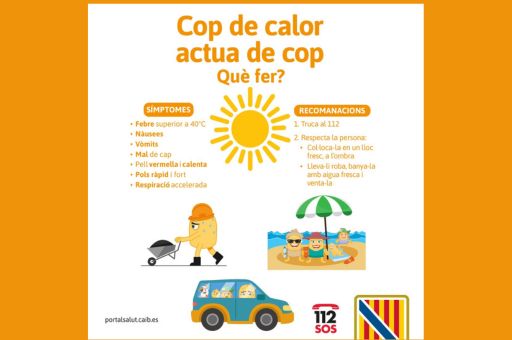Meteorology forecasts the first heatwave of this summer for the next few days.
On days with high temperatures, only do sport early or late in the day.
Given the AEMET forecast of high temperatures in the coming days, which could lead to the first heat wave of this summer, the Regional Ministry of Health is launching the advertising campaign ‘Viu l’estiu amb SENY. Protegeix-te de la colour to reinforce the prevention of heat stroke and whose posters will be placed on public transport. With it, the Directorate General of Public Health wants to remind the advice to avoid these episodes caused by intense exposure to the sun which, sometimes, can be fatal.
TDB keeps you informed. Follow us on Facebook, Twitter and Instagram
The Regional Ministry of Health reinforces the prevention of heat stroke with the campaign ‘Viu l’estiu amb SENY’
Over the next few days, from Thursday to Saturday, the Balearic delegation of the State Meteorological Agency (AEMET) is forecasting the first heat wave of the summer of 2024, with maximum temperatures that could reach 39 degrees Celsius in inland Mallorca on Friday. For this reason, it will decree yellow alerts for high temperatures, which could rise to orange by the end of the week.
This new institutional campaign is in addition to the one launched at the end of last month by the Ministry of Enterprise, Employment and Energy, through the Balearic Institute of Occupational Health and Safety (Ibassal), to prevent and deal with the problems of high temperatures in the Balearic Islands.
The recommendations of the General Directorate of Public Health are: avoid caffeinated and alcoholic drinks and eat light meals; reserve the first or last hours of the day for physical activity; drink water and wear light, cool clothing made of natural fabrics; never leave people or animals inside a parked and closed vehicle; and pay special attention to newborns, the elderly and outdoor workers.
How to recognise heat stress
The institutional campaign includes another message offering a series of guidelines on how to recognise heat stroke and the best way to act in order to minimise its effects. The most common symptoms of an episode of this type are a fever of over 40 degrees, nausea or vomiting, intense headache, warmth and redness of the skin and an acceleration of the pulse and breathing.
The best way to deal with these symptoms is to call the 112 emergency service quickly and, for the person affected by heat stroke, place them in a cool, shady place, remove clothing, cool them with water and fan them until the emergency services arrive.
New alert system
Since the 17th of June, the Epidemiology Service of the Directorate General of Public Health has had a new system in place for issuing high-temperature alerts that contemplates different values for different areas of Mallorca and the archipelago.
Unlike before, when the alert was only activated when a temperature of 34.4 degrees Celsius was reached at Palma airport, six zones have now been established in Mallorca and one each for Eivissa and Formentera and Menorca. Thus, while in the north and northeast of Mallorca, it will be activated from 34.8 degrees, in Palma it will be activated from 33.3 degrees.
Since 16 May, an information system has been in place, coordinated at the national level by the Centre for the Coordination of Alerts and Emergencies (CCAES) and the National Epidemiology Centre to establish preventive strategies in the face of a forecast period of high temperatures, with the aim of minimising the risks to health posed by exposure to these extreme heats.
The system involves receiving data on temperatures and associated mortality from different sources so that, in turn, the Epidemiology Service can forward them by e-mail to the different levels of health and social health care in the autonomous communities.
Since the beginning of the monitoring period, the Ministry of Health has provided maximum thresholds established for each region of the country. Thus, the Balearic Islands have set a maximum temperature of 33.3 degrees for the Palma-Airport Observatory; 33.9 degrees for the Serra de Tramuntana mountain range; 34.8 degrees for the north and northeast of Mallorca; 35.9 degrees for the interior of the island; 34.4 degrees for the south; and 34.3 degrees for the east of Mallorca. In Eivissa and Formentera the maximum threshold has been set at 33.1 degrees and in Menorca at 32.2.
Based on these thresholds, the temperature excesses forecast for the day and the next four days will be defined, as well as the actual records recorded the previous day. This plan will be in force until 30 September, although it is foreseen that it may be maintained until 15 October if the high temperatures persist.
Public Health maintains that this new zoning will allow the adoption of surveillance and risk measures specific to each area of this autonomous community, preventing the risks to the population associated with exposure to high temperatures.
The threshold temperatures for health impact due to high temperatures have been calculated by analysing the association between time series of mortality and temperature at the provincial level.
Three heat strokes in 2023
Last year, 25 possible cases of heat stroke were reported, of which only three were finally confirmed: two in Mallorca and one in Formentera. Two of those affected were in their 50s and the other was in his 26s. One was working in the fields, another in a kitchen and the third was doing physical activity. Since 2004, when this surveillance system was launched, 122 possible cases have been reported, of which 53 were confirmed. Of the latter, ten succeeded.
Sources from the Servei d’Epidemiologia have detailed that, during last summer, alerts were activated for fifteen days in July and August. Thirteen of them were level 1 (yellow, low risk) and two were level 2 (orange, medium risk).
